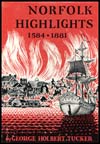Chapter 41
Early Norfolk Baptist Highlights
Freemason Street Baptist Church is the oldest existing Baptist house of worship in Norfolk.
An outgrowth of Cumberland Street Baptist Church and a lineal descendant of Norfolk's first racially mixed Baptist congregation that met during the early 1800s in the temporarily abandoned Borough Church, now St. Paul's Episcopal Church, the Freemason Street congregation was organized on May 25, 1848.
The story behind its origin is an interesting commentary on human frailty.
The minister of Cumberland Street Baptist Church was indiscreet enough to become engaged to two young women at the same time. And when he decided to favor one and slighted the other, a rift occurred in his congregation. Although the majority of his flock gave him a vote of confidence, eighty members decided to withdraw and establish a church of their own.
And since Thomas U. Walter, the celebrated Philadelphia architect who later designed the dome of the Capitol in Washington, was in Norfolk acting as a consultant on the Norfolk Court House then under construction, he was asked to provide a plan for the new church.
A good Baptist, Walter obliged, and the cornerstone was laid on August 14, 1848. Two years later, on May 30, 1850, the new church was dedicated. The Rev. Tiberius Gracchus Jones, one of the great figures in Virginia Baptist history, was its first minister.
The tall steeple of the church holds aloft the only one left of the dozens of plain and fancy old weathervanes that formerly indicated the direction of the wind in downtown Norfolk. Created by some long-forgotten Nineteenth Century tinsmith, the vane is an imaginative copy of Gabriel's trumpet. It was placed on top of the original spire (a much taller one than the present one) when the church was built.
According to tradition, a prominent Presbyterian who lived directly opposite the church objected strenuously to the original steeple because he was afraid that it might topple in a high wind and crash on his house. He was finally talked out of his objection, however, by a Baptist acquaintance who assured him that "The devil would hardly look for a good Presbyterian under a Baptist steeple."
The first Freemason Street steeple was the tallest structure in Norfolk from 1850 until it was blown down in the great August storm of 1879 that hit Norfolk on the morning of August 18. When it was over, half of the houses in the Norfolk area were roofless, and hundreds of trees were uprooted. At the height of the storm a reporter from The Norfolk Virginian, who was out checking on the damage, passed a woman in a doorway and heard her give a terrified shriek. When he asked what was wrong, she screamed, "My God, the Baptist steeple has blown down on all those houses!"
Fortunately she was wrong, for the steeple fell into Freemason Street instead. And when the debris was cleared away the weathervane was found thrust upright in the ground a considerable distance from the church.
At that time, many of those who were familiar with its appearance high in the air flocked to inspect it at closer range, and it was found to be so large that a tall man could stand upright in the larger end of the tin horn.
But the Freemason Street Baptists had to have their steeple, and when it was replaced with the present one, the trumpet weathervane was again on its top, where it continues to revolve with every passing breeze.
Chapter
42
Forrest - Norfolk's First Historian
Norfolk Highlights 1584 - 1881

See the "Table of Contents" for links to every chapter in Norfolk Highlights 1584 - 1881 by George Holbert Tucker.
